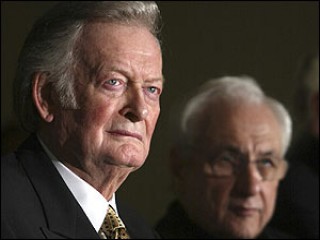
Kenneth Thomson biography
Date of birth : 1923-09-01
Date of death : 2006-06-12
Birthplace : North Bay, Ontario, Canada
Nationality : Canadian
Category : Famous Figures
Last modified : 2011-09-02
Credited as : businessman, art collector, top Forbes
Kenneth Thomson represented the second generation of a powerful and influential print and broadcast journalism family that had significant impact in both Great Britain and North America.
Born on September 1, 1923, in Toronto, Ontario, as the third child and only son of Edna and Roy Thomson, Kenneth Thomson inherited and then expanded the international business established by his father. In the 1984 book, The Thomson Empire, Susan Goldenberg chronicled the life of Roy Thomson as a failed auto parts dealer who rose to the British title Lord Thomson of Fleet, owner of the London Times and Sunday Times and a 20 percent owner of North Sea oil fields.
Kenneth Thomson married Nora Marilyn Lavis Thomson, and they had three children, David, Lynne, and Peter. The Thomsons lived quiet lives, with a large home in Toronto and a house in Kensington Palace Gardens in London. Kenneth Thomson used his title, Lord Thomson of Fleet, when in England, but refused to take his seat in the House of Lords because he did not wish to surrender his Canadian citizenship. Beginning when he was a 16-year-old disk jockey at CFCH, his father's first radio station, Kenneth Thomson was a fan of country and western music and, especially, of Canadian-born Hank Snow. Thomson even traveled to Nashville just to hear and meet Snow.
The Thomson empire had its beginnings when Roy Thomson acquired a franchise to sell De Forest Crosley radios in North Bay in 1930. This enterprise should have suffered significantly from the fact that North Bay is about 500 miles north of Toronto, that Canada was mired deep in the Great Depression, and that radio reception was uneven and spotty at best. To promote radio sales Roy Thomson opened his own radio station in North Bay, CFCH. This was, for a long period, a one-person operation, with Roy Thomson performing all the functions of the radio station and selling radios on the side. Eventually he began hiring new help, paying them mostly in experience.
Thomson invested all his earnings in expansion, buying additional radio stations and newspapers. In part, he said he bought the newspapers to expand advertising potential. By the early 1950s this policy had led to a significant communication network throughout Canada. In 1953, Roy Thomson moved to Great Britain and continued diversified business expansion. In 1966, he purchased the London Times and merged it with the Sunday Times, appointing his son Kenneth Thomson as the chairman of the board.
Kenneth Thomson's early career did not indicate that he would be as successful as his father. He went to prestigious Canadian private schools, enrolled in the University of Toronto, left to serve three years with the Canadian Air Force during World War II, and finally earned an MA in law from Cambridge University in 1947. From that point on he worked for the family business, serving as a beginning reporter on small newspapers in small Canadian towns. In The Thomson Empire, Susan Goldenberg suggests that his tenure throughout this early period was unremarkable and undistinguished. When Kenneth Thomson took over the family business after Roy Thomson died in 1976, most observers expected the family business to falter.
Such speculation proved unfounded. Kenneth Thomson did alter the direction of the business, slowly reorganizing the empire so that profits from North Sea oil were removed from the restrictions of Great Britain and transferred to Canadian corporations. Eventually the United Kingdom holdings became a subsidiary of a Canadian-based corporation. A clear indication of Kenneth Thomson's unwillingness to subject his companies to British business practices came in 1981 when, after a protracted struggle with the newspaper unions of Britain, he sold the Times and Sunday Times to Rupert Murdoch, who was, at that time, the Australian press entrepreneur.
Starting at the beginning of the 1980s, Kenneth Thomson expanded his companies' interests in publishing and printing in North America. Despite the fact that the Canadian Royal Commission on Newspapers took the Thomson chain to task for poor quality, the newspapers were profitable. The commission had been created by Pierre Trudeau, at the time Canadian prime minister, because of a fear generated by the fact that two companies, Thomson and Southam, owned 57 percent of Canada's newspapers.
Thomson also expanded his holdings in the United States. By 1985 Thomson had become the largest foreign investor in the United States' publishing industry. He spent over $1.5 billion acquiring small daily and weekly newspapers as well as such highly specialized publications as Jane's Fighting Ships, The American Banker, and The Journal of Taxation. In the early 1980s Thomson sought to add three to five American papers to his empire per year.
In later years Kenneth Thomson managed to retain the diversity of the Thomson empire, though the heart of the empire shifted away from British holdings. The Thomson companies were completely divested from British energy holdings, but they were rapidly moving into the field of electronic communications, particularly in the area of databases. In 1989 they acquired the Lawyers Cooperative Publishing Company of Rochester, New York. This made Thomson one of the largest legal publishers in North America.
The Thomson financial empire was secure going into the 1990's and expanded holdings in specialized information and electronic publishing, newspaper publishing in North America and leisure travel in the United Kingdom. William Symonds in Business Week (March 11, 1996) referred to Thomson as "Lord of Cyberpress." Thomson was listed in a July 1995 Forbes article as one of the ten richest men in the world.


















